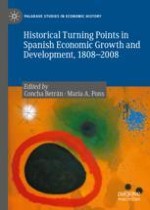2020 | OriginalPaper | Chapter
7. 2008: Spain in the Eye of the Perfect Storm
Authors : Jose Ignacio Conde-Ruiz, Elena Martínez-Ruiz
Published in: Historical Turning Points in Spanish Economic Growth and Development, 1808–2008
Publisher: Springer International Publishing
Activate our intelligent search to find suitable subject content or patents.
Select sections of text to find matching patents with Artificial Intelligence. powered by
Select sections of text to find additional relevant content using AI-assisted search. powered by
